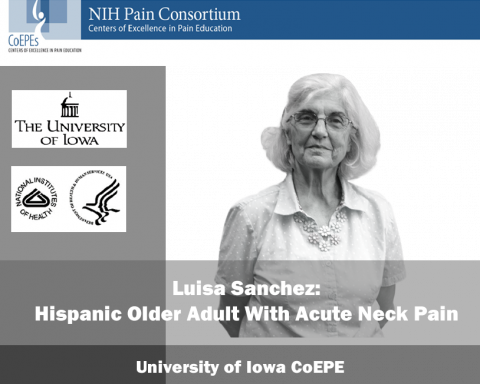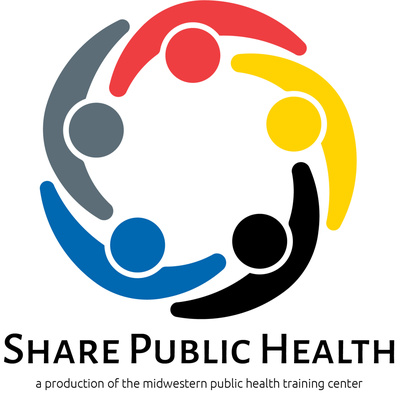The goal of this course is to provide an interactive learning experience about a 69-year-old Hispanic woman with acute neck pain that began two weeks ago.
Intended Audience
The intended audience for this course is pre-licensure students in the fields of medicine, nursing, and physical therapy.
Length
The length for this course is approximately 60 minutes depending on the individual user. Upon completion of the course, you will get a certificate of completion.
Course Content
This interactive module will cover three events:
- Event 1: Primary Care Visit
- Event 2: Physical Therapy Visits
- Event 3: Primary Care Provider Recheck
Measurable Outcomes
At the end of this training, you will be able to apply valid and reliable tools for measuring pain and associated symptoms to assess and reassess related outcomes and apply pain treatment options for Luisa Sanchez, a 69-year-old woman with Hispanic background with acute neck pain.
Learning Objectives
At the end of this module, you will be able to:
- Apply valid and reliable tools for pain assessment in an older adult with limited communication.
- Describe the important elements of oral health potentially impacting oral pain and dental examination in an older adult with limited communication.
- Create a treatment plan for an older adult with dental/oral pain with limited communication and memory.
Certificate of Completion
A Certificate of Completion is awarded on successful completion of this course. In order to successfully complete this course, you MUST:
Score 70% or higher on the posttest. If you do not receive 70% on the posttest, you may review the material and re-take the posttest.
Pain Management Domains and Competencies
This module will cover three domains of the Pain Management Competencies, domain 2, 3, and 4.
1. Domain Two: Pain assessment and measurement:
- Use valid and reliable tools for measuring pain and associated symptoms to assess and reassess related outcomes as appropriate for the clinical context and population.
2. Domain Three: Management of pain
- Identify pain treatment options that can be accessed in a comprehensive pain management plan
3. Domain Four: Clinical conditions: How does context influence pain management?
- Describe the unique pain assessment and management needs of special populations.
Presenter(s) and/or Content Experts
Primary Investigator (PI):
- Keela Herr, PhD, RN, AGSF, FGSA, FAAN
Co-Primary Investigator (Co-PI):
- Kathleen Sluka, PT, PhD
Project Coordinator:
- Eiko Oka, MPH
Case Developers Team:
- Dana Dailey, PhD, PT (Lead)
- Margo Shilling, MD
- Barbara St. Marie, PhD, ANP, GNP
- Sara Sanders, PhD, MSW
- John Swegle, PharmD
- Angela Chaparro-Arias, LMSW (Consultant)
Instructional Design Team:
- Nor Hashidah Abd Hamid, PhD (Instructional Designer)
- Laurie Walkner, MA, BSN (Instructional Design Coordinator)
- Melissa Richlen, BA (Media Specialist)
Actors:
- Therese Guedon - Mrs. Sanchez
- Angela Chaparro-Arias - Mrs. Sanchez’s Caregiver
- Kelly Fink - Medical Interpreter
- Nicola Jane Stickney - Primary Care Provider
- Carol Vance - Physical Therapist
Narrator:
- Dana Dailey, PT, PhD
- Melissa Richlen, BA
- Roger Hileman, MA
Reviewers (University of Iowa):
- Anthony Brenneman, MPAS
- Carrie Bernat, MA, MSW
- Jolie O’Conner, SPT
A special thanks to Hannah M Shultz for providing her effort on revising and completing the Spanish script.
Acknowledgements
The following organizations collaborated on the design and development of this course: The University of Iowa College of Nursing; The University of Iowa Carver College of Medicine (Department of Physical Therapy and Rehabilitation Science, Department of Physician Assistant, UIHC Department of Orthopedics and Rehabilitation, and UIHC Department of Family Medicine); The University of Iowa College of Pharmacy; The University of Iowa College of Liberal Arts & Sciences (School of Social Work); University of Iowa College of Public Health Institute for Public Health Practice (UICPH-IPHP); and Midwestern Public Health Training Center (MPHTC).
This project has been funded in whole or in part with Federal funds from the National Institutes of Health Pain Consortium, Department of Health and Human Services, HHSN271201500050C/ N01DA-15-4425 with The University of Iowa Center of Excellence in Pain Education (CoEPE).





